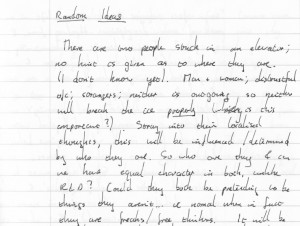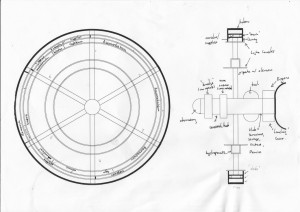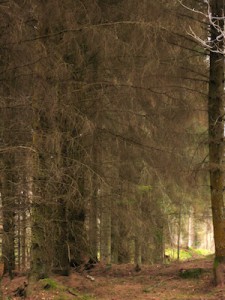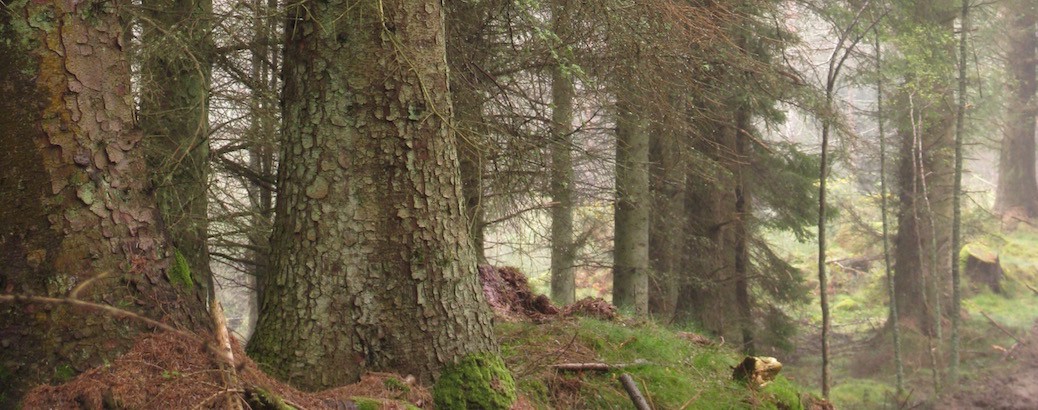The story of the Ark was started in late September 2013, almost by accident. I’d finished the first major draft of Ceremony of Mercy in the middle of August, and it just needed minor revisions before I was comfortable getting feedback from others.

However, whilst I was on a short holiday in the Lake district at the end of August, rather than making a start on these changes, I revisited some of the ideas about the power of belief that had been knocking around earlier in the year. Sadly, they didn’t come any more alive for a change of scenery, and once I was back, I duly set about making the changes to Ceremony of Mercy.
After sending out copies to my tame reviewers, I had a bit of space, but no conscious intention of starting another major project yet. However, one day an intriguing picture came to me from nowhere, of two people – a man and a woman – stuck in a lift.
 I didn’t know who they were, or how they’d got there, but I had a sense that they were responsible for the failure of the machinery. At first glance, this seemed a quite mundane, if unfortunate situation, but what if it wasn’t just an elevator in a building. What if the mechanism hadn’t been intentionally sabotaged, but rather affected by the occupants’ unconscious power of belief? As I followed these two threads, I became more and intrigued by where they were taking me. I saw the Earth almost destroyed by an out of control research project, a group of people escaping through the medium of a computer game, and through it all, the strange power of dreams.
I didn’t know who they were, or how they’d got there, but I had a sense that they were responsible for the failure of the machinery. At first glance, this seemed a quite mundane, if unfortunate situation, but what if it wasn’t just an elevator in a building. What if the mechanism hadn’t been intentionally sabotaged, but rather affected by the occupants’ unconscious power of belief? As I followed these two threads, I became more and intrigued by where they were taking me. I saw the Earth almost destroyed by an out of control research project, a group of people escaping through the medium of a computer game, and through it all, the strange power of dreams.
Even early on, I envisaged the Ark as being a multi-volume series, albeit written at the same time. Splitting the book up wasn’t for the sake of length, but to reflect the different feel of the parts. The structure of each ended up being quite different too, with the first having the alternate-chapter dream diary entries, and a busy, quite chaotic, multi-threaded nature. In contrast, the second volume is simpler and just follows the two threads of the protagonists. My hope was to make the two books self-contained, each having its own well-defined beginning and end.
 In fact, this was so successful, that when I came to start on the second book, there was a natural starting place – Matt standing in the street back on Earth – but little else. I knew where I wanted the characters to go and the themes to explore, but no mechanism to get there. Introducing a new character, the boy Luke, and having him “rescue Matt” felt very natural. However, I had little inclination about who he was at first, but he was always dangerous.
In fact, this was so successful, that when I came to start on the second book, there was a natural starting place – Matt standing in the street back on Earth – but little else. I knew where I wanted the characters to go and the themes to explore, but no mechanism to get there. Introducing a new character, the boy Luke, and having him “rescue Matt” felt very natural. However, I had little inclination about who he was at first, but he was always dangerous.
Perhaps I ought not have been so surprised about the sudden appearance of Luke. Some of the important themes in the Ark go back to the book I didn’t write before the Ceremony of Mercy. It’s probably a good opportunity to say a little bit more about that project. The main idea for it centred upon a father who, through a tragic car accident in which he had no blame, killed his own ten-year old son. Through his grief, he started to see odd things, and a part of him began to believe that his son was still alive/had come back. He was torn between believing he was going mad, seeing ghosts, or that something else quite inexplicable was going on. It is easy to see Luke as the man’s lost son, and Matt as the father, with the Oddness effect allowing the power of believe to affect reality. I won’t say more about the unfinished book, as one day I might return to it, but needless to say some of the ideas and characters found a home within the Ark.

The first draft was started in September 2013 and complete by late December. 170,000 words in a little over three months, written out longhand and then transcribed onto computer. A manic time to be sure, but the story was engrossing, and once I’d started on it, I wanted it complete before returning to The Ceremony of Mercy. After that, it sat on the shelf for three months.
Come the end of March, I picked it up again, awash with ideas that had bubbled up as I did the final revision of the Ceremony of Mercy. In May, I felt that the first volume, From the Shadows, was ready to see the light of day, and eagerly awaited feedback. However, I’d overreached, and it was depressing to learn that the book was too busy and confusing, with far too much going on at once. With reader feedback, I find it foolhardy to ignore, but the problem is often not as it’s presented. I felt the root of the issue was lack of context, a bit too little hand-holding, and a chaotic flow in places. So I changed the format of the dream diary entries, gave each scene a little pre-summary, and reordered the flow of some of the scenes so there was more continuity. This feedback also guided me as I revised the second volume, Return to Eden. The first book in the Ark series was completed in late August, and the second in mid-November.
 I wanted the cover art for From the Shadows to reflect the theme of the dark forest. So, in the middle of April, armed with my trusty Canon IXUS 960, I paid a visit to Crathes Castle, a favourite haunting ground of mine. I eventually chose this picture, mostly for the quality of the light peeping through the trees to the bottom right. In the book, it was the light within the trees, whether from the glowing eyes of the terrible animals or the fire from the sky, that was the gravest danger.
I wanted the cover art for From the Shadows to reflect the theme of the dark forest. So, in the middle of April, armed with my trusty Canon IXUS 960, I paid a visit to Crathes Castle, a favourite haunting ground of mine. I eventually chose this picture, mostly for the quality of the light peeping through the trees to the bottom right. In the book, it was the light within the trees, whether from the glowing eyes of the terrible animals or the fire from the sky, that was the gravest danger.
 A central theme in Return to Eden is the desertification of the towns and cities, and the surrounding landscapes. Ultimately, we discover that a huge desert that has absorbed most of Western Europe. But it’s also more than that, and is a reflection of the changes that one of the protagonists, Matt, has gone through. Again, I could have grabbed any number of stunning desert photos from the web, but I was after a very specific feel. I also thought that it’s rather difficult to judge the scale of features in pictures of deserts/beaches. Armed again with my camera and these ideas, this time I headed off to the Sands of Forvie.
A central theme in Return to Eden is the desertification of the towns and cities, and the surrounding landscapes. Ultimately, we discover that a huge desert that has absorbed most of Western Europe. But it’s also more than that, and is a reflection of the changes that one of the protagonists, Matt, has gone through. Again, I could have grabbed any number of stunning desert photos from the web, but I was after a very specific feel. I also thought that it’s rather difficult to judge the scale of features in pictures of deserts/beaches. Armed again with my camera and these ideas, this time I headed off to the Sands of Forvie.
